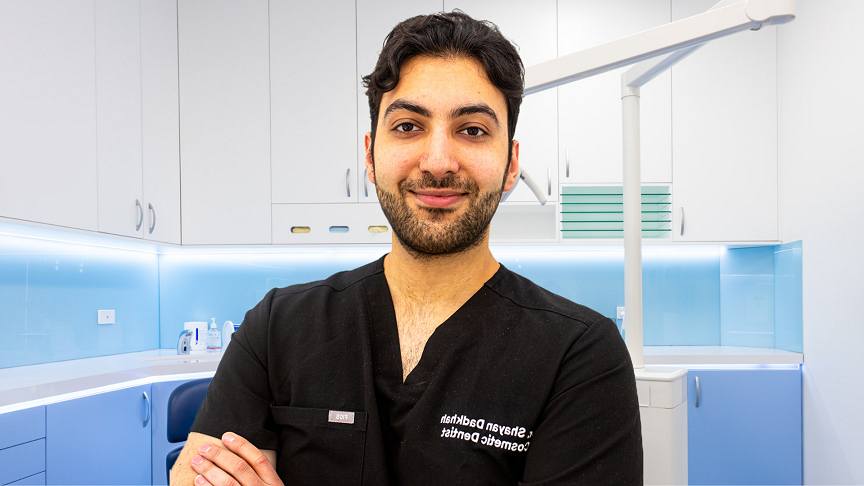If you’re considering getting veneers to enhance your smile, one of your first concerns might be:
“Are veneers painful?”
At Whites Dental, our expert veneer dentists in London hear this question every day. The short answer is no — getting veneers shouldn’t be painful when done correctly by experienced professionals.
In this article, we’ll explain exactly what to expect during the veneer process, address common myths about pain and share real insights from London patients who’ve undergone the treatment comfortably.
Key Takeaways
- Veneers are generally pain-free. Local anaesthetic ensures complete comfort during the procedure.
- Some patients experience minor sensitivity after preparation, but it fades within a few days.
- Porcelain and Emax veneers require minimal enamel removal, reducing discomfort.
- Choosing a skilled cosmetic dentist ensures precise preparation and pain-free results.
- Post-treatment care and sensitivity management help you heal quickly and enjoy a stunning new smile
What Are Veneers?
Dental veneers are ultra-thin porcelain or composite shells that are bonded to the front of your teeth to enhance the appearance of your smile. They are commonly used to:
- Whiten stained or discoloured teeth
- Repair chips or worn edges
- Close small gaps;
- Improve shape, symmetry and alignment
There are several types of veneers, including porcelain, Emax, composite, Lumineers and no-prep veneers. Each varies slightly in thickness, durability, and application method, but all aim to give you a natural, flawless smile.
💡 At Whites Dental London, our expert team tailors each veneer treatment plan to your smile goals and comfort level — ensuring your experience is smooth and stress-free.
Does Getting Veneers Hurt?

Let’s address the main concern directly: the process of getting veneers is not painful. During the procedure, your dentist uses a local anaesthetic to numb your teeth and gums before any enamel is removed. You won’t feel pain — only slight pressure or vibration during preparation. For no-prep veneers (like Lumineers), no anaesthetic is usually needed since little to no enamel is removed.
💡 Patients often describe the experience as similar to having a filling or dental cleaning — comfortable, straightforward and painless.
Why Veneers Don’t Hurt – The Science Behind It
Porcelain and Emax veneers sit on the tooth’s surface. Only a very thin layer of enamel (0.3–0.7mm) is gently buffed away to make room for the veneer, leaving the underlying tooth structure intact.
Since enamel doesn’t contain nerves, removing this tiny amount doesn’t cause pain. Any sensitivity occurs only if the dentin layer (beneath enamel) is slightly exposed — and even then, your dentist uses desensitising agents or numbing gels to prevent discomfort.
💡 Modern adhesive techniques and ultra-thin materials make today’s veneers minimally invasive and highly comfortable.
What To Expect During The Veneer Procedure
Here’s a step-by-step look at what happens when you get veneers at Whites Dental London:
1. Consultation And Smile Design
Your dentist assesses your teeth, discusses your goals and digitally designs your new smile using advanced imaging. This stage is completely painless.
2. Tooth Preparation
A thin layer of enamel is carefully removed (if needed), and local anaesthetic ensures you feel nothing. The dentist may place temporary veneers on the teeth to help with aesthetics and also patient comfort.
3. Impression Or Scan
Digital scans or moulds are taken to create perfectly fitted veneers.
4. Veneer Placement
Once your veneers are ready, they’re bonded using dental cement. The process is quick, gentle, and pain-free.
5. Follow-Up
A follow-up visit ensures the bite feels comfortable and that you’re adjusting well to your new smile.
Possible Sensations After Getting Veneers

While the procedure itself is pain-free, mild sensitivity after placement is normal. This can last 3–5 days and feels like a slight tingle when you eat hot or cold foods.
Common short-term effects include:
- Slight gum tenderness.
- Sensitivity to temperature changes
- Mild jaw tension if multiple veneers were placed
These sensations typically fade quickly and can be managed with:
- Over-the-counter pain relief (like ibuprofen)
- Using desensitising toothpaste
- Avoiding very hot or cold foods for a few days
💡 Your dentist at Whites Dental will also check your bite alignment to ensure no pressure points cause discomfort.
Are Some Veneer Types More Comfortable Than Others?
Yes — different materials and preparation techniques can influence how comfortable the treatment feels.
Porcelain Veneers
Porcelain veneers require light enamel removal but provide the most natural look and durability. Any sensitivity is minimal and short-lived.
Emax Veneers
Made of lithium disilicate, Emax veneers are thinner and require even less preparation — making them one of the most comfortable veneer options available.
No-Prep And Lumineers
These are the least invasive options. They sit directly on the natural tooth without drilling or anaesthetic, meaning zero pain and no recovery time.
💡 Your dentist will recommend the best type based on your smile goals and enamel condition.
Managing Sensitivity After Veneers
Here’s how to manage mild sensitivity post-treatment:
1. Use Sensitive Toothpaste
Brands like Sensodyne help soothe nerve endings and protect exposed dentin.
2. Avoid Extreme Temperatures
Stick to lukewarm foods and drinks for the first few days.
3. Brush Gently
Use a soft-bristled toothbrush and avoid aggressive brushing near the gum line.
4. Stay Hydrated
Water helps balance pH levels and reduces dryness that can worsen sensitivity.
5. Follow-Up Visits
Regular check-ups at Whites Dental London ensure your veneers remain perfectly bonded and irritation-free.
Pain-Free Alternatives: No-Prep Veneers
If you’re particularly nervous about discomfort, no-prep veneers or Lumineers may be ideal. They are ultra-thin (0.2–0.3mm) and can often be applied directly to the teeth with little or no enamel removal. Benefits include:
- No injections or drilling
- Immediate results
- Fully reversible in most cases
- Zero downtime;
💡 At Whites Dental Waterloo (SE1) and Marble Arch (W2), our dentists often recommend no-prep options for patients seeking a quick, non-invasive smile transformation.
What London Patients Say
“I was terrified it would hurt, but the whole veneer process was surprisingly relaxing. My smile looks amazing!”
– Emma, SE1
“I had Emax veneers on my teeth at Whites Dental at their Marble Arch clinic. The team was so gentle — I didn’t feel a thing, not even during the prep!”
– James, W2
“I experienced a little sensitivity for a day or two, but it was worth it. Now I can’t stop smiling!”
– Laura, SE1
Why Choosing The Right Dentist Matters
Comfort during veneer treatment depends heavily on the dentist’s experience and precision. At Whites Dental London, our team uses:
- Digital smile design for accurate planning
- Minimally invasive techniques to preserve enamel
- Advanced bonding systems for seamless results
- Local anaesthesia and numbing gels for complete comfort
💡 Our dentists take the time to ensure every step is painless, from consultation to final polish.
How Veneers Feel After Placement
Once bonded, veneers should feel natural — like your own teeth. You’ll be able to speak, chew, and smile confidently within hours of the procedure.
💡 If a veneer feels slightly “off” or high when you bite down, your dentist can make minor adjustments. Most patients forget they even have veneers after the first week.
Long-Term Comfort And Maintenance
Veneers are designed to last 10–15 years or more with proper care. They don’t cause ongoing discomfort, and with regular check-ups, they remain securely in place. To keep your veneers comfortable and your smile bright:
- Visit your dentist every 6 months for cleaning.
- Consider investing in a night guard if you think you may be grinding your teeth at night.
- Avoid using teeth to open packages or bite hard foods
- Maintain excellent oral hygiene
Why Choose Whites Dental In London
At Whites Dental, we have two centrally located dental veneer clinics in London:
Whites Dental Waterloo – 172 Blackfriars Rd, London SE1 8ER | 020 8616 0590
Whites Dental Marble Arch – 52B Kendal St, St George’s Fields, London W2 2BP | 020 3576 2325
We specialise in Porcelain Veneers, Emax Veneers, Lumineers and No-Prep Veneers, providing bespoke smile transformations across London.
Book a free veneers consultation with one of our expert veneer dentists in London.
💡 Our experienced cosmetic dentists combine artistry with advanced technology to create beautiful smiles — comfortably.
How Veneers Compare To Other Cosmetic Treatments
| Treatment | Pain Level | Longevity | Stain Resistance | Invasiveness |
|---|---|---|---|---|
| Porcelain Veneers | Minimal | 10–15 years | ⭐⭐⭐⭐ | Moderate |
| Emax Veneers | Minimal | 15+ years | ⭐⭐⭐⭐⭐ | Low |
| Composite Veneers | Mild | 5–7 years | ⭐⭐ | Low |
| No-Prep Veneers | None | 10+ years | ⭐⭐⭐⭐ | Very Low |
Key Tips To Ensure A Comfortable Veneer Experience
- Discuss numbing options and your comfort level with your dentist beforehand
- Choose experienced cosmetic dentists with proven veneer success stories.
- Avoid internet myths — modern veneers are minimally invasive and virtually painless.
- Follow all aftercare instructions carefully.
Conclusion
So, are veneers painful? Not at all. With today’s technology and expert care from clinics like Whites Dental London, the process is smooth, comfortable and rewarding. Whether you choose Porcelain, Emax or No-Prep Veneers, you can enjoy a dazzling new smile with minimal sensitivity and maximum confidence.
💡 Visit us at Whites Dental Waterloo (SE1) or Marble Arch (W2) to discover how we can help you achieve your dream smile — pain-free.
